World Trends on DAISY Development
Romain Deltour
Development Team Leader of Pipeline 2
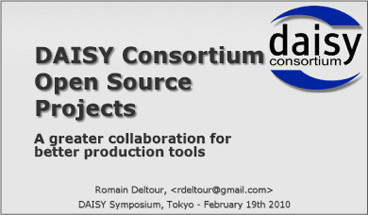
Good afternoon. It's obvious from the previous presentations that we are seeing very interesting changes. The legal context is changing. We are seeing an increasing use of digital formats, and of course, we need some tools to support these changes.
I am going to talk today about the open sources of tool development that we do at the Daisy Consortium. I will first briefly describe the general context of accessible content production. Then I'll talk about the Consortium's strategy regarding software development. And then I'll introduce both automated and interactive authoring projects of the Daisy Consortium. So let's have a look at the general context.
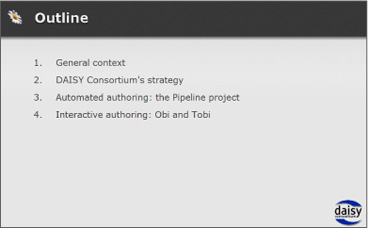
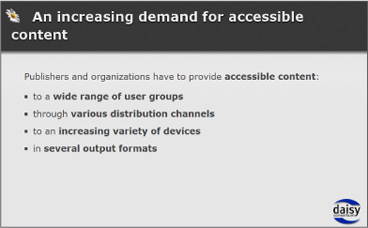
We're seeing an increasing demand for accessible content. Access to information, equal access to information, is a fundamental human right, and publishers and organizations have to provide more and more accessible content to a wider range of user groups, going from the blind and visually impaired, dyslexics, deaf persons, cognitively disabled persons. This content must be provided through various distribution channels and through an increasing variety of devices. And last but not least, the contents must be provided in several output formats. Examples of such output formats are, for instance, Daisy 2, the Daisy 3 standard, the upcoming Daisy 4 distribution formats that have been described by Marcus previously. Of course, the E-PUB, which is increasingly used in the consumer market. We also need to produce large print, Braille, and potentially other formats.
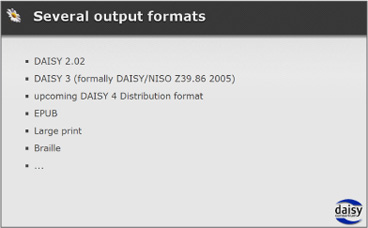
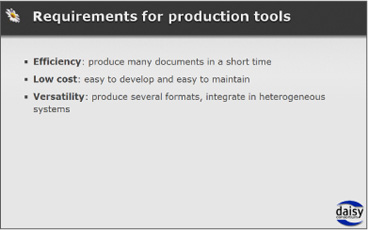
So what are the basic requirements for production tools? Production tools need to be efficient, low cost, and versatile. Efficiency means that we need to produce as many documents as possible in the shortest time possible. For instance, when you have to deliver the news to thousands of people, you cannot wait a week to do that. We cannot leave the disabled person behinds, so we need to have very efficient production tools. These tools need to be low cost; they need to be easy to develop and easy to maintain over time. And they need to be versatile. They need to be able to produce content in several output formats. They need to integrate very well in heterogeneous use systems in the mainstream publishing tool chains in desktop applications everywhere.
So what is the Consortium's strategy in regard to software elements? This slide on the screen shows a map that shows the worldwide distribution of Daisy members, and we see that the Daisy community is spread all over the world. We have hundreds of organizations, distributed over more than 35 countries.
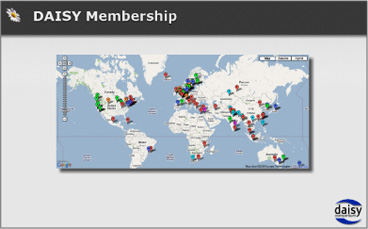
And imagine that each of these organizations develop their own tools and their own proprietary formats: that would be such a waste of time and effort. So the true answer is to create collaborative projects, and only very strong and international collaboration is the key to the production of efficient tools. This allows us to lower the development cost. To increase the quality, the more users we have, the more bugs are reported, the more fixes we can bring.
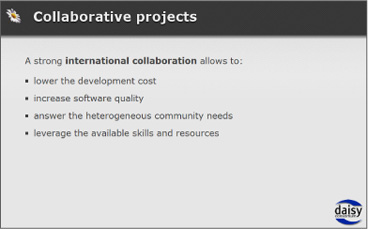
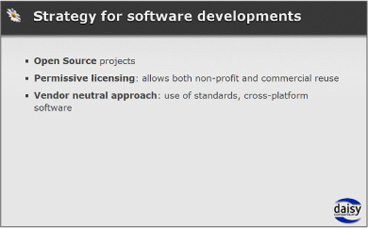
We can also leverage the available skills and resources of all our member companies. And finally, using a collaborative environment, we can really answer all of the needs of the community. If Japanese organizations or publishers have specialized needs, such as the need to represent text vertically, then if we can collaborate in the production and development of these tools, we can bring these needs into the tools. So to implement such collaborative development projects we promote the use of, the creation of open source projects, and we use permissive licensing solutions. This allows both for-profit and nonprofit to reuse our tools, which means that an organization can use our tools free of charge if it wants, or a commercial vendor can reuse our tool, possibly adapt it and then sell it commercially. As much as we can we also try to adopt a vendor neutral approach, and this goes through the use of standards, technical standards.
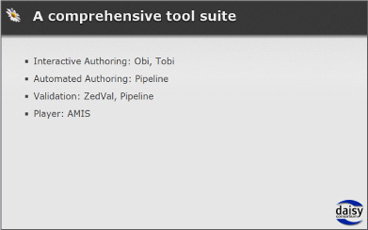
We also try to develop cross-platform software as much as we can. And using this strategy over the past few years, the Consortium has developed a comprehensive tool suite. This goes bottom up from interactive authoring, automated authoring, then when you author the contents you have to validate it to ensure that it conforms to the specifications, so we have validators of course. And after that you have to be able to read it, so we also developed a player, AMIS player.
Let's have a look at the automated authoring solution of the Daisy Consortium, which is the Daisy Pipeline project.
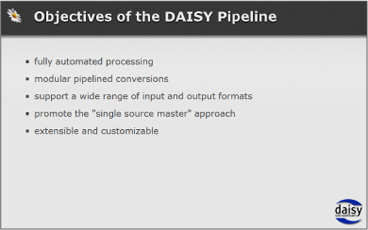
The main objective of the Daisy Pipeline project is to implement fully automated processing of documents. We want to be able to convert from one input format to another output format. We want to be able to validate some documents. We want to be able to enhance the documents. All of this in an automated way. A job in the Daisy Pipeline is actually a sequence of tasks. So the Pipeline has to adopt a module architecture for Pipeline conversion. It needs to support a wide range of input and output formats in order to satisfy all the user demands. And to allow the support of this wide range of output formats, we actually promote the single source master approach, which has already been mentioned by the other three previous presenters. In this single source master approach, we actually use a central XML document that is rich enough, so we can extract several output formats out of it.
For instance, if we use Daisy XML, such as the Daisybook documents or the Daisy 4 authoring and interchange formats, as the single source document, then we can apply automated processing to create a wide range of output formats out of it, including E-PUB, including Daisy 4 distribution, including audio books, including Braille, large print, even PDF.
And finally, a very important objective of the Pipeline is to be extensible and customizable. Every organization that chooses to adopt the Pipeline must be able to extend it to answer its own needs and possibly customize it to its own requirements.
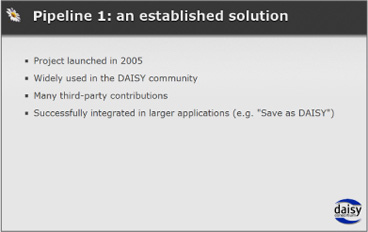
The Pipeline is actually an established solution. The project was first launched in 2005 and released in 2007. It's already widely used in the Daisy community, by a lot of Daisy members. We have received many, many third party contributions, many of the tasks, conversion tasks currently available in the Pipeline have been develop by Daisy organizations. The project has been successfully integrated into larger systems. The Pipeline can be integrated into automatic production tool chains. It can also be integrated into third party desktop applications; for instance,if any of you have already seen Microsoft Save As DAISY-add-in, the "Lite" weight version of the Pipeline is used underneath to run the conversion. But as usual with software development, if you don't move forward, often you move backwards because emerging technologies are appearing.
It's the time to prepare the way for the future. And so we are currently starting the next-generation Pipeline, smartly called Pipeline 2.
This new generation project consists mostly in a fundamental redesign of the core engine framework, and we really want to build underpriced grade solutions.
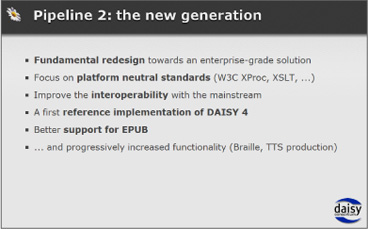
We'll focus on platform neutral standards, such as the standards developed by W3C XProc, XSLT, and this will allow us to improve the interoperability with the mainstream and the publisher tool chains. This project will start with implementing a reference implementation of the Daisy 4 authoring and interchange formats, and the idea is to harmonize the development of Pipeline 2 with the developments of the upcoming Daisy 4 version, so that when the Daisy 4 standard is available we have some tooling to produce some contents on the Daisy 4 standard.
The production of Daisy 4 authoring and interchange will allow us to adopt the single source master approach to later be able to produce the other output formats. A primary goal of the Pipeline project is also to provide better support for E-PUB, and progressively over time we'll bring some additional functionalities, such as the production of Braille or TTS-based production of audio books.
So the general approach of the project is to go through two development phases.
The first phase running through May 2010 to September 2011 will consist of the core redesign of the framework and the support of the Daisy 4 authoring and interchange formats. And the second phase, starting from September 2011 to September 2013, will bring extended functionality and more deployment options.
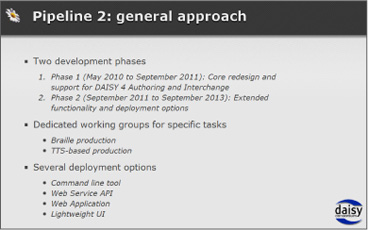
We also create working groups to work on dedicated tasks, such as Braille production, or the TTS-based production, and finally, ultimately, we will develop several deployment options, so we will be able to call the software as a common line tool, but also as a Web service API, so you can call it from anywhere, basically. We'll also try to develop some Web applications, so we can use the centralized installation of the Pipeline within an organization, for instance. And of course, we will also develop a "Liteweight" user interface, so it can be integrated within other third party applications.
Now let's have a quick look as well at the interactive authoring solutions developed at the Daisy Consortium.
First, Obi is an audio recording tool; it allows the production of audio-only books with a table of contents, navigation table of contents.
I've included a screen shot of Obi. It basically consists in several panes; the central user face element is a set of stripes, and each of these stripes represents an audio chunk with a ray form that you can edit. Obi is used to provide audio-only books that don't include any text and it's really easy to use with a minimal amount of training and it's a fully accessible Windows application and supports being localized in several languages. It was released last year I think, and it's currently being used by an increasing number of organizations, and it is greatly appreciated by, its ease of use is greatly appreciated.
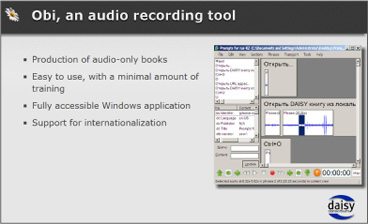
The other interactive authoring solution is called Tobi; it's a production tool for accessible multimedia formats. Unlike Obi, Tobi allows the production of synchronized text and audio. It's a fully accessible Windows application. It's currently under heavy development by a team of Daisy staff members. It supports the import of Daisy XML or E-PUB, and out of it you can produce accessible multimedia documents such as Daisy 3 documents. It proposes an intuitive workflow for synchronized audio recordings and editing, and it is based on a heavily modular software architecture so that more functionality can later be provided by a set of plug-ins.
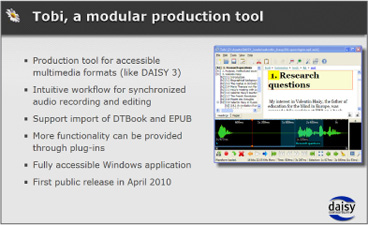
So all of these software projects hosted by the Daisy Consortium are following a really strong collaborative approach which allows us to create quality tools and hopefully improve the availability of accessible contents to print-disabled people. Thank you.
